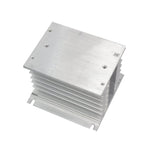All orders, wherever possible are shipped the same day within the UK as long as it is received before 1 pm.
Orders placed on Friday after 1 pm or the weekend will be dispatched on Monday.

Heatsink for SSR 10-120A CTR models, size 80x80x100mm
A heat sink for three-phase solid-state relays (SSRs) is essential to dissipate the heat generated by the SSRs during their operation. SSRs control the flow of current without the use of mechanical contacts, which makes them suitable for various applications. However, they still generate heat, especially in high-current or high-frequency applications, and this heat must be efficiently managed to ensure the proper functioning and longevity of the SSRs.
Here are some considerations for selecting and using a heat sink for three-phase SSRs:
1. Heat Sink Selection:
- Ensure that the heat sink you choose is rated for the current and voltage requirements of your three-phase SSRs. It should have a current and voltage rating compatible with your SSRs' specifications.
- Select a heat sink with adequate thermal performance (measured in thermal resistance in °C/W) to dissipate the heat generated by the SSRs. The lower the thermal resistance, the better the heat dissipation.
2. Mounting:
- Properly mount the SSRs to the heat sink using appropriate thermal compound or thermal pads. This helps to maximize the heat transfer from the SSRs to the heat sink.
- Make sure that the SSRs are securely fastened to the heat sink to ensure good thermal contact.
3. Airflow:
- Ensure that there is adequate airflow around the heat sink to carry away the heat. This is particularly important in applications where the SSRs operate continuously or at high power levels.
- Use fans or natural convection, depending on your application, to enhance heat dissipation.
4. Proper Sizing:
- The size of the heat sink (its dimensions) should be appropriate for the application and environment. Larger heat sinks can dissipate heat more effectively but may not be suitable for all applications due to size constraints.
5. Temperature Monitoring:
- Implement temperature monitoring and over-temperature protection for your SSRs and heat sink to prevent overheating and damage. This can be achieved using temperature sensors and control systems.
6. Insulation:
- Ensure that the heat sink is electrically isolated from the SSRs and the electrical system to avoid potential short circuits or safety hazards.
7. Consult the SSR Manufacturer:
- Check the datasheets and documentation provided by the SSR manufacturer for specific recommendations and guidelines related to heat sink selection and usage.
Remember that the effectiveness of the heat sink is highly dependent on the specific application and operating conditions. It's important to perform thermal analysis and testing to ensure that the heat sink can effectively dissipate the heat generated by the three-phase SSRs, especially in high-power or continuous operation scenarios.
All orders, wherever possible are shipped the same day within the UK as long as it is received before 1 pm.
Orders placed on Friday after 1 pm or the weekend will be dispatched on Monday.
Vous possédez un compte ?
Connectez-vous pour payer plus vite.